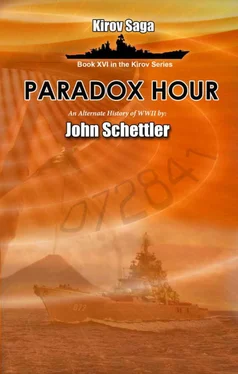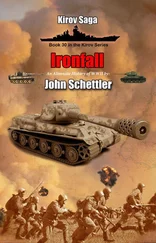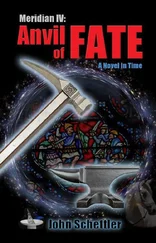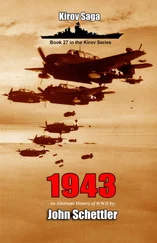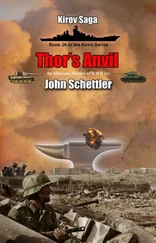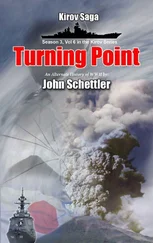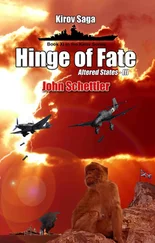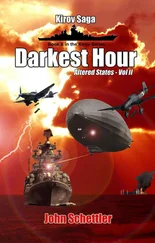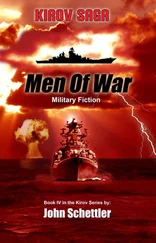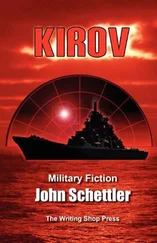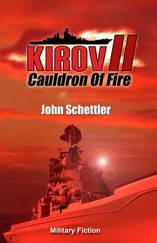“Well lads,” he said, tapping the deck three times with his stout blackthorn walking stick. “Now we earn our grog. Make ready on the torpedo mounts, and increase to full ahead.”
* * *
KapitanHeinrich smiled when he saw the British destroyers begin their impudent charge. It was just as he expected. Technically the enemy was now attempting to close with him, and his orders stated that he should disengage and steer 300, but he saw no reason to do so at the moment.
“Schirmer, do you think you can hit one of those with our main batteries?”
“It would make for good target practice, sir.”
“Then clear your throat. It’s high time we gave the guns a little work.”
“Very good sir! With your permission, I will open fire immediately.”
Seconds later Kaiser’s forward twin turret opened the engagement, the salvo meant to test the range calculated by the directors. Schirmer was watching closely, and when the big guns fired, he waited for the rounds to fall, seeing they were short, but much closer than he expected.
“Fire Bruno!” he said sharply, knowing that those guns were set on the same range as his spotting salvo. If he was lucky, the simple speed of the two opposing sides would close that range just enough to make this shot interesting.
And he was lucky that day. He saw the two rounds fall right astride the formation of enemy ships, so close to one destroyer that the tall plumes of seawater drenched the ship’s foredeck, and shell splinters riddled the side of its hull. Now Schirmer knew he had the range, and he quickly gave orders to account for nothing more than the range that would be gobbled up by two ships closing on one another at nearly 36 knots each.
“Elevation down three! Ready…. Fire!”
This time both turrets fired at once, sending the same shell weight that Bismarck might throw from her own forward guns. Kaiser Wilhelm was no ship to be trifled with, and when the second salvo fell, the British learned this the hard way.
“A hit! My god! We got them at just under 30,000 meters!” Schirmer turned to his Kapitan, eyes alight, elated to have scored his first ever hit with this new ship, and what a hit it was.
Impulsive was the unlucky ship that day, struck aft with such force that the shell nearly broke the ship in two. The only ship ever to bear that name in the Royal Navy, she had sustained a rogue hit that would leave her crippled and wallowing in the sea. They saw the remaining two British destroyers break formation, and begin a wild, zig-zag approach, tacking to port and starboard to make themselves much more difficult targets. Schirmer knew he would probably not be so lucky again with his main guns, but in a matter of minutes he could bring his secondary batteries into play, six twin 15cm, 5.9-inch guns, the very same as those used by Bismarck and Scharnhorst, and he could get four of those in to action at 23,000 meters. After that, the eight dual purpose 4.1-inch guns would have to wait until the range fell inside 17,000 meters. That battery alone matched all the guns on those destroyers, and now the thirty torpedoes Lieutenant Commander Maud had hoped to call on had been reduced to twenty.
Yet the British persisted in their brave charge. Schirmer shook his head, realizing the maneuver was desperate, though he gave the men on those destroyers his grudging respect.
The whims of chance, however, had put Mother Time in a most uncomfortable position, for the two ships remaining had both played an important role in the long wake of the story that was still unfolding with this action. Of the two ships, Icarus was perhaps the most vulnerable in her eyes, for that ship had already died according to her ledger, and to find it here was the first sprouting root of the paradox that was slowly growing with each passing second.
Icarus had died. It was killed by Kirov , but Captain Maud must live, and Intrepid must live with him, or Orlov would never be found that day in 1942 when Duero hit Werner Czygan’s mine.
Yet all this rested on a thin foundation, the assumption that this altered world was the same one that Kirov was destined to visit that very year, in just a few months time. How could that be possible? The ship was already there, and the world Kirov displaced to looked nothing like this one. For Werner Czygan and Lieutenant Commander Maud to matter at all, Kirov would have to have been chased across the Med by Rodney and Nelson in 1942. But how could that happen now with Kirov an ally of the Royal Navy?
Time was in a strange position as these events twisted slowly back upon themselves, like a mother hen fretting over eggs that had not yet been laid. On the one hand, Icarus and Intrepid , and the men aboard them, were crucial links in the line of causality that saw Kirov now at sea in these very waters. On the other hand, they seemed entirely immaterial, as those events were not likely to ever occur. Yet their fate would count heavily on one ledger, the reckoning of the account of one Captain Wells, and the ship he now sailed—HMS Glorious .
Glorious was a ship of ghosts, men who had once been doomed, their names written into the ledger of time by the hand of death, and the 11-inch shells of Scharnhorst and Gneisenau . Now, like the ship itself, they were living second lives. Only 38 of the men aboard had been destined to live, all the rest were walking dead, zombies, gifted with life only because of a brief moment’s delay in the telegraph room that had spared one Lieutenant Commander Christopher Hayward Wells, now the spectral Captain of this ship of fated men.
As he stood on the bridge that day, anxiously watching the damage crews fighting the fire on the bow, Wells had a strange inkling that fate was still scratching at his leg, jealous, hungry, and resentful of every breath he took. He could not know that he had been destined to die, but he could feel it, like a cold draft at the edge of an open door to a cellar. He could feel it.
Lieutenant Commander Lovell was on the bridge that day, as was his good friend Robert Woodfield, and both men seemed edgy as well. The situation they now found themselves in seemed all too familiar, for this was the second time the ship had encountered fast German raiders at sea, and few ships ever get second chances when they came under enemy guns. Glorious already had more than her fair share.
The ship had just celebrated its 26th birthday. Originally designed as a battlecruiser, along with her sister ship Courageous , she was laid down on the 1st of May in 1915, built by Harland and Wolff, a company that had recently launched another pair of doomed sister ships, the Titanic and Britannic . One sunk on her maiden voyage, and the other was soon lost in the Aegean in 1916 after striking a mine. And so the shipwrights in the know had whispered that a curse was on the keels of ships laid down in that yard, and no good would come to any ship built there.
Commissioned in 1917, Glorious and Courageous both seemed to prove the rumors wrong, leading charmed lives in the beginning. They both fought at the Battle of Heligoland Bight that same year, when it was discovered that the simple act of firing their guns was sufficient to warp and damage the lightly armored deck structure. So the two ships went into fleet reserve, and for a time Glorious served only as a gun turret operations training ship before someone in the Royal Navy decided the two ships might be easily converted to a new role as aircraft carriers.
Читать дальше
